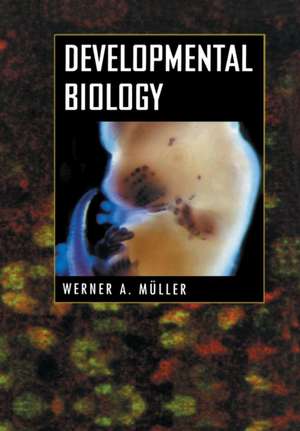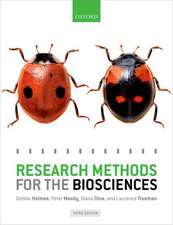Developmental Biology
Autor Werner A. Mülleren Limba Engleză Paperback – 26 sep 2011
Preț: 397.01 lei
Nou
Puncte Express: 596
Preț estimativ în valută:
75.98€ • 79.03$ • 62.72£
75.98€ • 79.03$ • 62.72£
Carte tipărită la comandă
Livrare economică 14-28 aprilie
Preluare comenzi: 021 569.72.76
Specificații
ISBN-13: 9781461274728
ISBN-10: 1461274729
Pagini: 396
Ilustrații: IX, 328 p.
Dimensiuni: 170 x 244 x 21 mm
Greutate: 0.63 kg
Ediția:Softcover reprint of the original 1st ed. 1997
Editura: Springer
Colecția Springer
Locul publicării:New York, NY, United States
ISBN-10: 1461274729
Pagini: 396
Ilustrații: IX, 328 p.
Dimensiuni: 170 x 244 x 21 mm
Greutate: 0.63 kg
Ediția:Softcover reprint of the original 1st ed. 1997
Editura: Springer
Colecția Springer
Locul publicării:New York, NY, United States
Public țintă
Lower undergraduateCuprins
1. Development: Organisms Construct and Organize Themselves on the Basis of Inherited Information.- 2. Basic Stages, Principles, and Terms of Developmental Biology.- 3. Model Organisms in Developmental Biology.- 4. Comparative Review: The Phylotypic Stage of Vertebrates, Common versus Distinct Features, and Aspects of Evolution.- 5. The Egg Cell and the Sperm Get a Dowry.- 6. The Start: Fertilization and Activation of the Egg.- 7. Precisely Patterned Cleavage Divisions Are Driven by an Oscillator.- 8. Determination: Cells Are Programmed and Committed to Their Fates.- 9. Epigenetic Pattern Formation: New Patterns Are Created During Development.- 10. Differentiation Is Based upon Differential Gene Expression that Is Programmed during Determination.- 11. Cell Differentiation Frequently Is Irreversible and Causes Cell Death; Early Cell Death Can Be Programmed.- 12. Animal Morphogenesis Is Shaped Actively by Adhesion and Cell Migration.- 13. Cell Journeys: Even Germ Cells and Cells of the Peripheral Nervous System Originate from Emigrant Precursors.- 14. Development of the Nervous System: Cell Migration, Pathfinding, and Self-Organization.- 15. Heart and Blood Vessels: Divergent Developmental Roads but One System in the End.- 16. Stem Cells Enable Continuous Growth and Renewal.- 17. Signal Molecules Control Development and Growth.- 18. Cancer Comes from Disturbed Growth and Differentiation Control.- 19. Metamorphosis: A Second Embryogenesis Creates a Second Phenotype.- 20. Sex and the Single Gene.- 21. Regeneration and Renewal versus Loss and Death.- 22. Life and Death: What Is the Major Mystery?.- Boxes.- Box 1 History: From the Soul to Information.- Box 2 Famous Experiments with Eggs and Embryos: Cloning, Chimeras, Teratomas, and Transgenic Mice.- Box 3 The PI Signal Transduction System.- Box 4 Models of Biological Pattern Formation.- Box 5 Signal Molecules Acting through Nuclear Receptors.- Box 6 How Cells Communicate and Interact.- Box 7 Contemporary Techniques in Developmental Biology.









